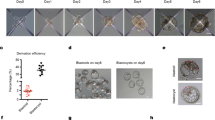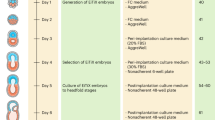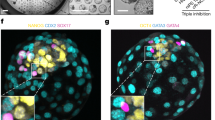Abstract
WHEN preimplantation mouse embryos are transplanted to extrauterine sites, up to 20% develop almost normally to the egg cylinder stage (equivalent to about 6–7 d in utero). They then become disorganised and give rise to tumours, which are usually mature teratomas containing a wide range of differentiated tissues, but less frequently are progressively growing teratocarcinomas containing nests of undifferentiated pluripotent embryonal cells1,2. There are many reasons why it would be interesting to reproduce such normal and abnormal development efficiently in vitro. Although a number of techniques have been used to culture preimplantation embryos, none of them has proved entirely satisfactory3–5; in the best conditions only 5–20% of 3.5–4-d blastocysts develop in vitro to form differentiated, foetal tissues. Most only give rise to extraembryonic endoderm and its associated mesoderm; these cell types proliferate extensively in vitro, and consequently most of the continuous lines derived from blastocyst cultures have probably originated from extraembryonic tissues6. In this paper we describe a simple and reproducible method for culturing mouse blastocysts in vitro so that around 70% give rise to colonies which continue to grow for up to 4 weeks and produce a variety of differentiated tissues, including skin, nerve, beating muscle, cartilage and fibroblasts. The method relies on the technique of immunosurgery7 for killing and removing first the trophectoderm and then the hypoblast (primary endoderm) layers of the embryo, to yield clumps of isolated epiblast (embryonic ectoderm) (Fig. 1).
This is a preview of subscription content, access via your institution
Access options
Subscribe to this journal
Receive 51 print issues and online access
$199.00 per year
only $3.90 per issue
Buy this article
- Purchase on Springer Link
- Instant access to full article PDF
Prices may be subject to local taxes which are calculated during checkout
Similar content being viewed by others
References
Stevens, L. C. J. Embryol. exp. Morph. 20, 329–341 (1968).
Stevens, L. C. Devl Biol. 21, 364–382 (1970).
Cole, R. J. & Paul, J., in Preimplantation Stages of Pregnancy, Ciba Foundation Symposium (ed. Wolstenholme, G. E. W. and O'Connor, M.) 82–112 (Churchill, London, 1965).
Hsu, Y.-C. Nature 231, 100–102 (1971).
Hsu, Y.-C., Baskar, J., Stevens, L. C. & Rash, J. E. J. Embryol. exp. Morph. 31, 235–245 (1974).
Sherman, M. I. Cell 5, 343–349 (1975).
Solter, D. & Knowles, B. Proc. natn. Acad. Sci. U.S.A. 72, 5099–5102 (1975).
Mintz, B. in Methods in Mammalian Embryology (ed. Daniel, J. C.) 196–197 (Freeman, San Francisco, 1971).
Hogan, B. L. M. Nature 263, 136–137 (1976).
Spiegelman, M. & Bennett, D. J. Embryol. exp. Morph. 32, 723–738 (1974).
Skreb, N., Svajger, A. & Levak-Svajger, B. in Embryogenesis in Mammals, Ciba Foundation Symposium, 40, 27–39 (Elsevier, Amsterdam, 1976).
Diwan, S. & Stevens, L. C. J. natn. Cancer Inst. 57, 937–938 (1976).
Grobstein, C. J. exp. Zool. 119, 355–379 (1952).
Hunt, T. E. Anat. Rec. 68, 349–369 (1937).
Author information
Authors and Affiliations
Rights and permissions
About this article
Cite this article
HOGAN, B., TILLY, R. In vitro culture and differentiation of normal mouse blastocysts. Nature 265, 626–629 (1977). https://doi.org/10.1038/265626a0
Received:
Accepted:
Issue Date:
DOI: https://doi.org/10.1038/265626a0
This article is cited by
-
Culturing the epiblast cells of the pig blastocyst
In Vitro Cellular & Developmental Biology - Animal (1993)
-
Mouse blastocyst immunosurgery with commercial antiserum to mouse erythrocytes
In Vitro Cellular & Developmental Biology - Animal (1993)
-
Is the similarity of monozygotic twins due to genetic factors alone?
Nature (1981)
-
The in vitro morphogenesis of the guinea pig egg cylinder
Anatomy and Embryology (1981)
-
Regeneration of endoderm by ectoderm isolated from mouse blastocysts
Nature (1977)
Comments
By submitting a comment you agree to abide by our Terms and Community Guidelines. If you find something abusive or that does not comply with our terms or guidelines please flag it as inappropriate.



